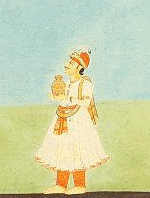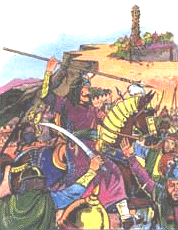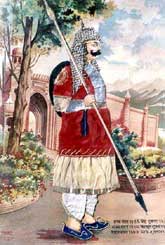dowry. It crowns a seven-mile- long hill, covering 700 acres (280 hectares), with its fortifications, temples, towers and palaces.
From the eighth to the 16th century, Bappa Rawal's descendants ruled over an important kingdom called Mewar stretching from Gujarat to Ajmer. But during these eight centuries the seemingly impregnable Chittor was surrounded, overrun, and sacked three times.
In 1303 Allauddin khilji, Sultan of Delhi, intrigued by tales of the matchless beauty of Padmini, Rani of Chittor, of her wit and charm, decided to verify this himself. His armies surrounded Chittor, and the sultan sent a message to Rana Rattan Singh, Padmini's husband, to say that he would spare the city if he could meet its famous queen. The compromise finally reached was that the sultan could look upon Padmini's reflection if he came unarmed into the fort. Accordingly, the sultan went up the hill and glimpsed a reflection of the beautiful Padmini standing by a lotus pool. He thanked his host who courteously escorted Allauddin down to the outer gate-where the sultan's men waited in ambush to take the rana hostage.
There was consternation in Chittor until Padmini devised a plan. A messenger informed the sultan that the rani would come to him. Dozens of curtained palanquins set off down the hill, each carried by six humble bearers. Once inside the Sultan's camp, four well-armed Rajput warriors leaped out of each palanquin and each lowly palanquin bearer drew a sword.In the ensuing battle, Rana Rattan Singh was rescued-but 7,000 Rajput warriors died. The sultan now attacked Chittor with renewed vigor. Having lost 7,000 of its best warriors, Chittor could not hold out. Surrender was unthinkable. The rani and her entire entourage of women, the wives of generals and soldiers, sent their children into hiding with loyal retainers. They then dressed their wedding fine , slid their farewells, and singing ancient hymns, boldly entered the mahal and performed jauhar.
The men, watching with expressionless faces, then donned saffron robes, smeared the holy ashes of their women on their foreheads, flung open the gates of the fort and thundered down the hill into the enemy ranks, to fight to the death.The second sack or shake (sacrifice) of Chittor, by which Rajputs still swear when pledging their word, occurred in 1535, when Sultan Bahadur Shan Of Gujarat attacked the fort.

Rana Kumbha
Rana Kumbha
Rana Kumbha (1433-68) was a versatile man a brilliant, poet and musician. He built mewar upto a position of assailable military strength building a chain of thirty forts that girdled the kingdom But, perhaps more important was a patron of the arts to rival Lorenzo de Medici, and he made Chittorgarh a dazzling cultural center whose fame spread right across Hindustan.

Rana Sanga
Rana Sanga
Rana Sanga (reigned 1509-27) was a warrior and a man of great chivalry and honor reign was marked by a series of continual battles, in course of which he is said to have lost one arm and had been crippled in one leg and received eighty-four wounds on his body. The last of his battles was again Mughal invader, Babur, in 1527. Deserted by one ofgenerals, Rana Sanga was wounded in the battle and shortly after.

Maharana Pratap
Maharana Pratap
Over the next half-century, most other Rajput rulers allowed themselves to be wooed the Mughals; Mewar alone held out. In 1567 Emperor Akbar decided to teach it a lesson: he attacked Chittorgarh razed it to the ground. Five years later Maharana Pratap (reigned 1572-97) came to rule Mewar - a king without a capital. He continued to defy Akbar, and in 1576, confronted the imperial armies at Haldighati.
The battle ended in a stalemate and Maharana Pratap and his followers withdrew to the craggy hills of Mewar, from where they continued to harrass the Mughals through guerilla warfare for the next twenty years. Maharana Pratap made his descendants vow that they would not sleep on beds, nor live in palaces, nor eat off metal utensils, until Chittorgarh had been regained.In fact, right into the 20th century the maharanas of Mewar continued to place a leaf platter under their regular utensils and a reed mat under their beds in symbolic continuance of this vow.
T
No comments:
Post a Comment